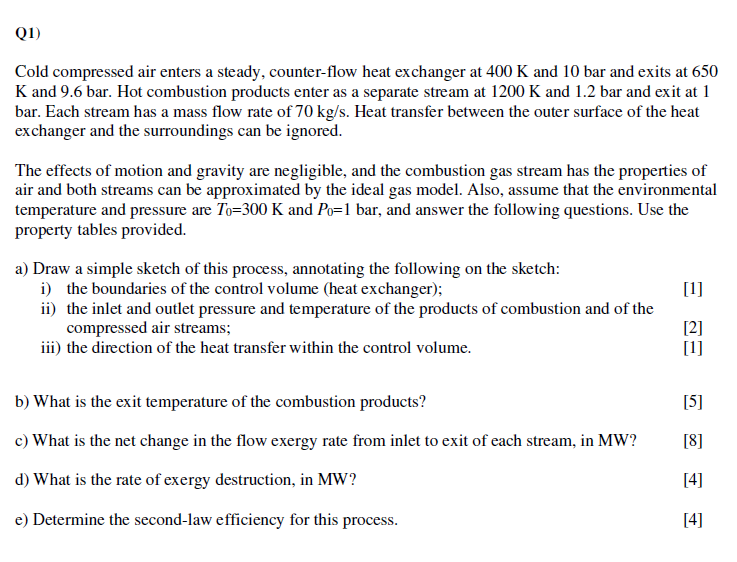
Cold compressed air enters a steady, counter-flow heat exchanger at 400K and 10 bar and exits at 650 K and 9.6 bar. Hot combustion products enter as a separate stream at 1200K and 1.2 bar and exit at 1 bar. Each stream has a mass flow rate of 70kg/s. Heat transfer between the outer surface of the heat exchanger and the surroundings can be ignored. The effects of motion and gravity are negligible, and the combustion gas stream has the properties of air and both streams can be approximated by the ideal gas model. Also, assume that the environmental temperature and pressure are T0=300K and P0=1 bar, and answer the following questions. Use the property tables provided. a) Draw a simple sketch of this process, annotating the following on the sketch: i) the boundaries of the control volume (heat exchanger); [1] ii) the inlet and outlet pressure and temperature of the products of combustion and of the compressed air streams; [2] iii) the direction of the heat transfer within the control volume. [1] b) What is the exit temperature of the combustion products? [5] c) What is the net change in the flow exergy rate from inlet to exit of each stream, in MW? [8] d) What is the rate of exergy destruction, in MW? [4] e) Determine the second-law efficiency for this process. [4] Cold compressed air enters a steady, counter-flow heat exchanger at 400K and 10 bar and exits at 650 K and 9.6 bar. Hot combustion products enter as a separate stream at 1200K and 1.2 bar and exit at 1 bar. Each stream has a mass flow rate of 70kg/s. Heat transfer between the outer surface of the heat exchanger and the surroundings can be ignored. The effects of motion and gravity are negligible, and the combustion gas stream has the properties of air and both streams can be approximated by the ideal gas model. Also, assume that the environmental temperature and pressure are T0=300K and P0=1 bar, and answer the following questions. Use the property tables provided. a) Draw a simple sketch of this process, annotating the following on the sketch: i) the boundaries of the control volume (heat exchanger); [1] ii) the inlet and outlet pressure and temperature of the products of combustion and of the compressed air streams; [2] iii) the direction of the heat transfer within the control volume. [1] b) What is the exit temperature of the combustion products? [5] c) What is the net change in the flow exergy rate from inlet to exit of each stream, in MW? [8] d) What is the rate of exergy destruction, in MW? [4] e) Determine the second-law efficiency for this process. [4]







